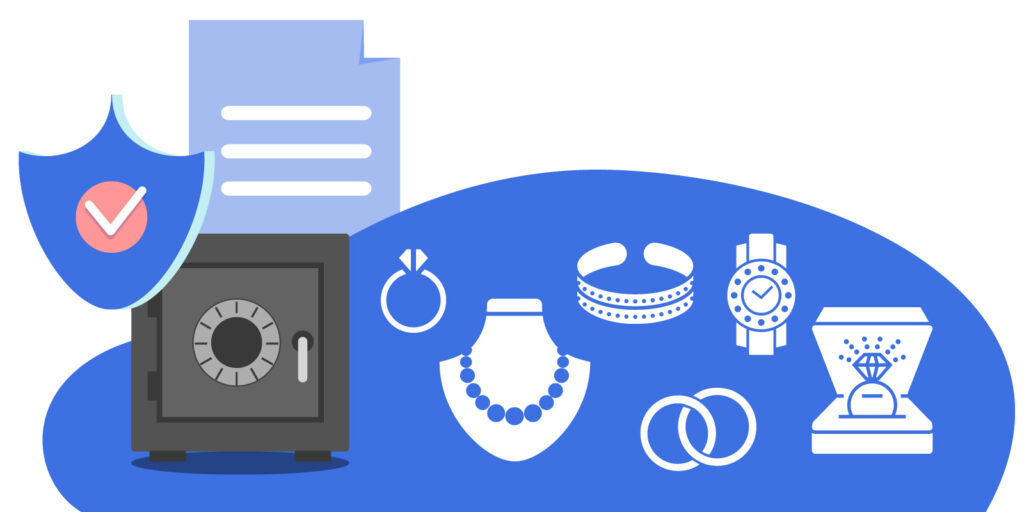Humans started wearing jewelry about 5,000 to 6,000 years ago, turning shells, stones and other natural objects into some of the first statement pieces in civilization. Today, the global jewelry market is worth more than $300 billion, making it an important part of the economy.
Whether your drawers are filled with rings, necklaces, earrings and bracelets, or you have just one sentimental piece of jewelry, you need to protect yourself against loss and theft. Keep reading to learn more about jewelry insurance and why you need it.
Standard Insurance Coverage
Many people mistakenly believe they don’t need jewelry insurance if they already have a homeowners or renter’s insurance policy coverage. While these policies do provide some coverage for jewelry, there are some major gaps you should know about.
Coverage Limits
Even if your standard policy covers jewelry, it may only cover a small amount. For example, some policies cover the loss or theft of jewelry worth up to $1,500. If you have a diamond ring worth $5,000, that’s not enough to protect your investment. Even if the amount of the loss is under your coverage limit, your premiums may increase if you file a claim.
Some types of loss are excluded from homeowner’s and renter’s insurance policies. For example, your policy may not cover a necklace lost in the rubble of a severe earthquake. You may also have no recourse for certain types of loss or theft. For example, if you drop a ring down the drain, your insurance company may not pay to replace it.
Policy Deductibles
In insurance lingo, a deductible is an amount of money you must pay out of your own pocket before your insurance starts covering any of your losses. If you file a claim on a lost bracelet worth $2,000 and your deductible is $1,500, that means you’ll only get $500 from the insurance company.
Blanket Jewelry Coverage vs. Scheduled Personal Property Coverage

If you need extra protection beyond what your standard insurance policy covers, there are two types of jewelry insurance to consider. The first is blanket jewelry coverage, which increases the amount that an insurance policy pays for any type of jewelry. If you currently have a limit of $2,000, you may be able to buy a jewelry rider that increases the amount of coverage to $7,500. Note that even if the total limit increases, your insurance company may limit the amount of money it pays out for specific items.
Scheduled personal property coverage works a little differently. Instead of buying blanket coverage for a large collection, you buy coverage for specific pieces of jewelry. If you own an engagement ring and a wedding ring, for example, you can buy dedicated coverage for each one. This allows you to get around the per-item limits that typically come with blanket coverage. Another benefit of scheduled personal property coverage is that it may cover a wider range of losses. If you accidentally drop your ring down the drain, for example, scheduled personal property coverage may cover it.
Comprehensive Jewelry Insurance
Blanket jewelry coverage and scheduled personal property coverage are typically added to an existing insurance policy. If you need more comprehensive coverage, it’s possible to buy a stand-alone jewelry policy. These policies usually cover a lot more than what your standard policy would cover, such as damage caused by a natural disaster. Depending on the terms of your policy, standalone jewelry insurance may pay to replace your items or pay a jeweler to repair any damage.
Comprehensive jewelry insurance has several benefits:
- It’s separate from your standard insurance policy, so you won’t have to pay more for homeowner’s or renter’s insurance if you have to file a jewelry claim.
- Standalone policies cover a variety of problems.
- If you lose one piece from a set of jewelry, a standalone policy is likely to cover the loss.
- You generally don’t have to pay a deductible.
You should be aware that comprehensive jewelry insurance policies don’t cover normal wear and tear, intentional losses, damage related to armed conflicts or manufacturer defects. Jewelers Mutual, GemShield and BriteCo all sell standalone insurance policies for jewelry.
The Cost of Jewelry Insurance
If you’re interested in a standalone policy, you can expect to pay 1% to 2% of the value of each item in your collection. Assume your jewelry collection includes a ring worth $5,000, a watch worth $500 and a necklace worth $750. If the insurance company charges 1.5% of each item, a standalone policy would cost you less than $100 per year. Insurance premiums vary based on where you live, the value of your insured items and whether you choose to insure the replacement value or the actual value of each piece.
You calculate the actual value of an item by taking the original cost and subtracting the loss of value associated with age and use (depreciation). For example, if you purchased a ring for $5,000 and wore it for five years, it might be worth $2,500 after accounting for depreciation. Replacement value refers to how much it would cost you to replace the item today. If you paid $5,000 for the ring five years ago, it might cost even more to replace it today due to high inflation rates. Insuring an item for its replacement value costs a little more, but it also ensures that you can replace the item without dipping into your own funds.
Jewelry Service Plans and Warranties
Many jewelers offer service plans to help you keep your jewelry in good condition. For example, if you have a rhodium-plated ring, a jewelry service plan may include regular polishing. A service plan may also cover bent prongs and other types of damage. While these plans are helpful, they don’t cover loss or theft.
Warranties cover damage associated with manufacturer defects, such as pitting that weakens the structure of a ring. They don’t cover theft or other types of losses, making them rather limited in the amount of protection they provide.
You might also be interested in: Everything You Need to Know About Insuring Your Musical Instruments





